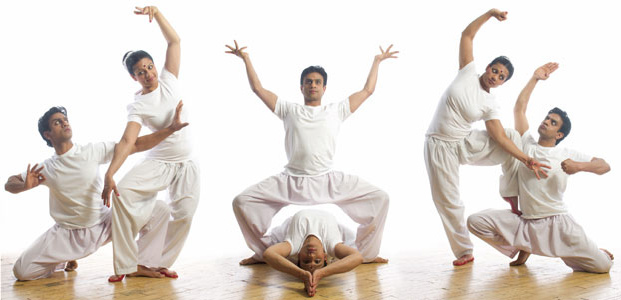Timescape

Sunday, July 12, 2009
Betty Oliphant Theatre
R.A. Laidlaw Centre
400 Jarvis St.
Toronto, Ontario
Timescape was a 'one night only' one hour dance production created and performed by Ellora and Devraj Patnaik. Featuring contemporary choreography and music rooted in Indian classical disciplines, this piece demonstrated the abilities of the two performers, at their fullest, through an exploration of sound, movement and rhythms.
With wireless microphones taped to the left side of their faces and the accompanying wireless pack to the inside of their bare left thighs, the sister-brother duo took a theme of Time in its various forms and created a journey through evolution.
With a single candle in her hand, Ellora Patnaik inaugurated the work by holding three still poses each in a silent special downstage to symbolize the past, present, and future.
With sound being the first singular force to create the universe, the main opened and revealed Devraj holding a Tanpura and singing an Alap in Raga Kamodi.
A heartbeat began to start time through rhythm. Ellora and Devraj created forward and backward clocks at different speeds to visually elaborate, merging together to form the core of the burning sun. From the sun, the planets burst forth and spun.
On earth, the water flowed over the lands and the flowers bloomed. This segment utilized a great deal of Indian Classical grammar but the music was all contemporary beginning with the heartbeat. Each dancer left the stage and dragged onto the stage large white cloths and twirled with them giving the blurring visual for a transition to men evolving on earth. Survival, chores, and agriculture were shown through all choreographic grammar and the dancers spun into a standing straight position and tied the cloths around their waists.
The next segment was in silence as the dancers experimented with free movement which merged into small aesthetics of Odissi dance. It grew comical when Devraj would imitate in high sharp speed the movement Ellora would be doing in a slow clear speed. The game of 'copy cat' continued into a clapping frenzy where Ellora held the tempo for Devraj who clapped on his knuckles, hands, and chest. Ellora then got the audience to clap the rhythms she clapped until they clapped to a small segment that the duet danced to.
Then they began to makes sounds with their voices. They shouted the vowels out from the Oriya alphabet and then recited the entire Oriya alphabet in strange pulses with an African rhythm playing on the CD. It ended with a bang and they show the pakhawaj drum with the ghungroo bells around it at stage left.
As Ellora took the bells and left the stage to wear them, Devraj gave a pakhawaj solo of different rhythms. Ellora entered with her ghungroo and danced 'the question and the answer' segment called Jugalabandhi, the competition between the pakhawaj player's drum and the dancer's anklet bells. Ellora then mimed the decorating of her self as Devraj played the pakhawaj and sang a Pallavi in Raga Kamodi. At the end of the segment, Devraj stood up with two sticks in his hand and hit them together at Ellora's feet and left the stage. This symbolized conflict.
Ellora wept in mime after she removed the bells and abandoned them at the drum. Devraj entered and hit the sticks at Ellora's feet again and she left the stage. When she entered with a six foot long dowel, a stick fight ensued with beautiful rhythms created only with the two small sticks, the large dowel, and the stage floor. The sticks were then utilized for the duet to have a small comical Bhangra section. They then drop their sticks and went into battle in bare hands with large heavy striding movement.
Upon falling to the ground in exhaustion, Ellora and Devraj both sang a song to the Goddess Mother who defeated the Buffalo Demon, which symbolized the Feminist Power. The demon fell to the Goddess at the end of a beautiful Odissi Battle choreography as Ellora and Devraj traditionally do.
Ellora freed her tresses and fried Devraj like bacon, rolled him like a roti, and boiled him in her cauldron with contemporary movement. He burnt in Hell as the Goddess in Her Witch Form tormented him which gave him his path to heaven. Ellora left the stage to bind her hair and grab her candle. As Devraj left the stage to grab his two candles, Elloa entered the auditorium and paid homage to the audience when she circled her candle in and through the audience house as Devraj did to the corners of the stage at the same time.
They met together on the riser and stood above three candles before them in a duet pose that symbolized the past, present, and future. The heartbeat was heard once again demonstrating that time, as ever, goes on…
